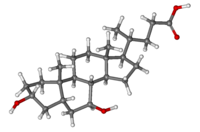
Photo from wikipedia
ABSTRACT Cholecystectomy rates for biliary dyskinesia in children are rising in the United States, but not in other countries. Biliary dyskinesia is a validated functional gallbladder disorder in adults, requiring… Click to show full abstract
ABSTRACT Cholecystectomy rates for biliary dyskinesia in children are rising in the United States, but not in other countries. Biliary dyskinesia is a validated functional gallbladder disorder in adults, requiring biliary colic in the diagnosis. In contrast, most studies in children require upper abdominal pain, absent gallstones on ultrasound, and an abnormal gallbladder ejection fraction (GBEF) on cholecystokinin-stimulated cholescintigraphy for diagnosis. We aimed to systematically review existing literature in biliary dyskinesia in children, determine the validity and reliability of diagnostic criteria, GBEF, and to assess outcomes following cholecystectomy. We performed a systematic review following the PRISMA checklist and searched 7 databases including PubMed, Scopus, Embase, Ovid, MEDLINE, ProQuest, Web of Science, and the Cochrane library. Bibliographies of articles were screened for additional studies. Our search terms yielded 916 articles of which 28 were included. Three articles were manually added from searched references. We reviewed 31 peer-reviewed publications, all retrospective chart reviews. There was heterogeneity in diagnostic criteria and GBEF values. Outcomes after laparoscopic cholecystectomy varied from 34% to 100% success, and there was no consensus concerning factors influencing outcomes. The observational, retrospective study designs that comprised our review limited interpretation of safety and efficacy of the investigations and treatment in biliary dyskinesia in children. Symptoms of biliary dyskinesia overlapped with functional dyspepsia. There is a need for consensus on symptoms defining biliary dyskinesia, validation of testing required for diagnosis of biliary dyskinesia, and randomized controlled trials comparing medical versus surgical management in children with upper abdominal pain.
Journal Title: Journal of Pediatric Gastroenterology and Nutrition
Year Published: 2017
Link to full text (if available)
Share on Social Media: Sign Up to like & get
recommendations!